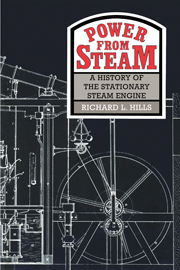Book contents
- Frontmatter
- Contents
- Preface
- Acknowledgements
- List of figures
- List of tables
- 1 The noblest machine
- 2 The impellent force of fire
- 3 Common old smoaking engines
- 4 The economy of power
- 5 The devil of rotations
- 6 Such unbounded power
- 7 Good servants but bad masters
- 8 An uncultivated field
- 9 The new theory of heat
- 10 The internal operation of the machine
- 11 Such absolute smoothness
- 12 Twinkle twinkle little arc
- 13 The drive for efficiency
- 14 An economical source of motive power
- 15 The most economical mode of obtaining power
- Notes
- Bibliography
- Index
9 - The new theory of heat
Theories of Carnot, Clausius, Joule and others (1820–1850)
Published online by Cambridge University Press: 01 June 2011
- Frontmatter
- Contents
- Preface
- Acknowledgements
- List of figures
- List of tables
- 1 The noblest machine
- 2 The impellent force of fire
- 3 Common old smoaking engines
- 4 The economy of power
- 5 The devil of rotations
- 6 Such unbounded power
- 7 Good servants but bad masters
- 8 An uncultivated field
- 9 The new theory of heat
- 10 The internal operation of the machine
- 11 Such absolute smoothness
- 12 Twinkle twinkle little arc
- 13 The drive for efficiency
- 14 An economical source of motive power
- 15 The most economical mode of obtaining power
- Notes
- Bibliography
- Index
Summary
It is but just, however, to state that the new theory of heat, now being submitted to the test of experiment, will modify very much the theory of the steam-engine. Until the new views, however, have been conclusively affirmed, it would be premature to specify them.
So wrote Robert Burn in 1854. For a long time people had been puzzling over what was the actual driving force behind the steam engine. It is interesting that Savery stated that his engine would work by the ‘impellent force of fire’ and that the early atmospheric engines were called ‘fire engines’. Watt also was acutely conscious of the importance of heat in a steam engine which was shown by his use of the steam jacket and hence, in effect, lagging the cylinder. We have seen how this awareness was, in some degree, due to his understanding of the science of heat through his connections with the men of science of his day like Black who had just founded the new science of heat. Engineers after Watt, like Smeaton, Brindley, Ewart, and Fairbairn, had no such link with this science and they derived their theories from hydraulic engineering which thought in terms of water pressure or weight. The result was that often their concept of the operation of steam engines was deficient.
An example of these confused ideas was shown by the thinking of Farey. He could see that the role of heat was essential when he wrote in Rees's Cyclopaedia,
Steam is a fluid so different from air, as to have no one property in common with it, except elasticity. […]
- Type
- Chapter
- Information
- Power from SteamA History of the Stationary Steam Engine, pp. 162 - 172Publisher: Cambridge University PressPrint publication year: 1989



